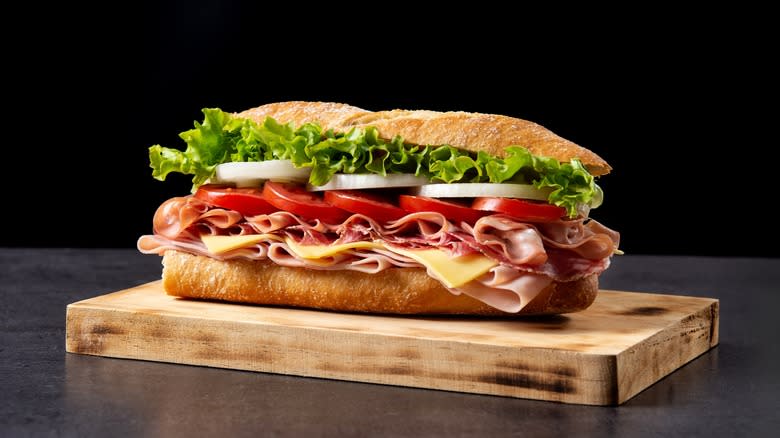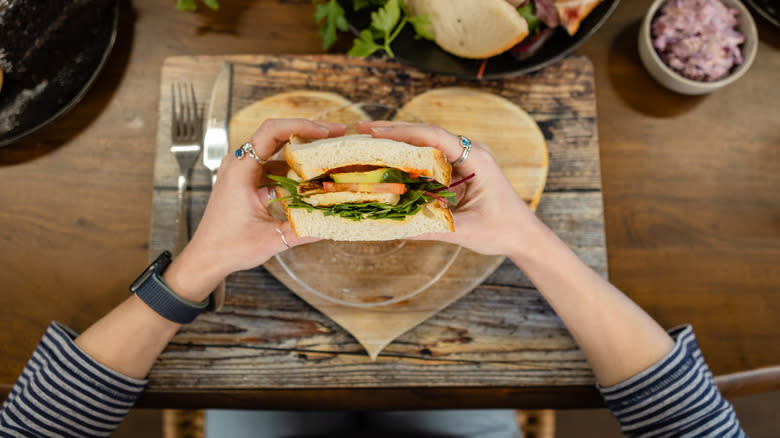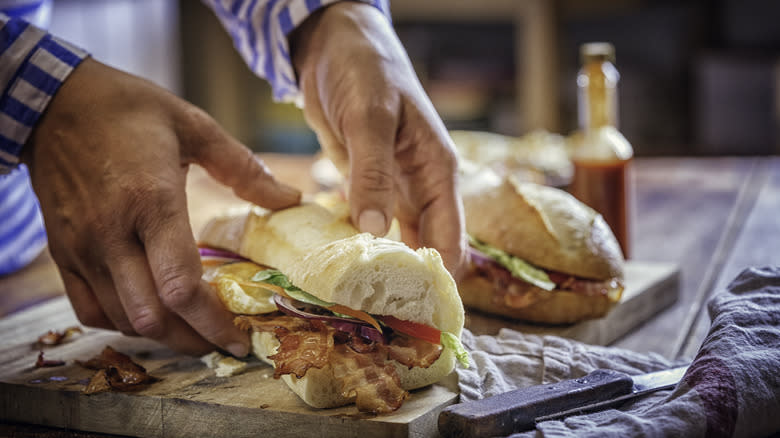Never Eat A Soggy Sandwich Again With This Clever Condiment Trick

From the humble ham and cheese to the flavorful bánh mì, there are few things better in life than a well-made sandwich. Along with meats, cheeses, and vegetables, condiments are a non-negotiable sandwich addition for most people. However, they can imperil the stability of your sandwich by making the bread hopelessly soggy. Fortunately, you can avoid a lunchtime catastrophe by adding condiments between sandwich fillings, as opposed to slathering them directly onto the bread.
No matter which of the many different mustard varieties you choose for your sandwich, adding this and other condiments with care will prevent the bread from becoming overly saturated. The amount of the condiments you add can also make a big difference in avoiding soggy textures. In this case, use a dollop of mustard or mayo when adding condiments to the center of your sandwich. To give you an idea, the average ham and cheese recipe calls for just three tablespoons of mustard.
Read more: The 18 Unhealthiest Store-Bought Sliced Breads You Can Buy
How To Handle Slippery Sandwich Fillings

Much like your favorite condiments, certain fillings can also contribute to sogginess and stability of your sandwich. This is definitely true of tomatoes, which have a tendency to slide around sandwiches due to moisture content. Like mustard and mayo, soggy fillings like tomatoes, pickles, and avocados work best when they're placed in the middle of the sandwich. However, you can prevent them from going rogue by creating a protective layer consisting of leafy green vegetables.
The texture of leafy greens is better for gripping ingredients, which stops them from moving as you eat the sandwich. They also prevent moisture-rich toppings from saturating the bread. Along with common options like spinach and lettuce, consider including something like arugula in your sandwich. When it comes to spinach versus arugula in the battle of leafy greens, arugula is praised for its subtle peppery flavor and earthiness, which creates a more complex flavor profile than you would get with spinach (although spinach is more nutritious).
Other Smart Ways To Reduce A Soggy Sandwich Outcome

While careful construction of your sandwich is key, the type of bread you choose to build it with can also deter sogginess. For instance, the robust texture of sourdough is perfect for making a sturdy sandwich, as is rye bread, which offers the added benefit of sizeable slices to keep your sandwich fillings fully intact. A baguette is another good choice when it comes to stability, especially if you're making a big sandwich with lots of meat and fillings (in this case, consider these tips on how to make the best possible Italian beef sandwich).
When it comes to any veggies you plan to include, remove lingering moisture by patting them dry with a paper towel. With excess water eliminated, you can now incorporate vegetables into the sandwich without concerns about affecting the texture and stability of the bread. And if you're not planning on eating your magnificent creation immediately, further safeguard against sandwich instability by wrapping it first with parchment paper or aluminum foil, then placing it into a sealable plastic bag.
Read the original article on Daily Meal

